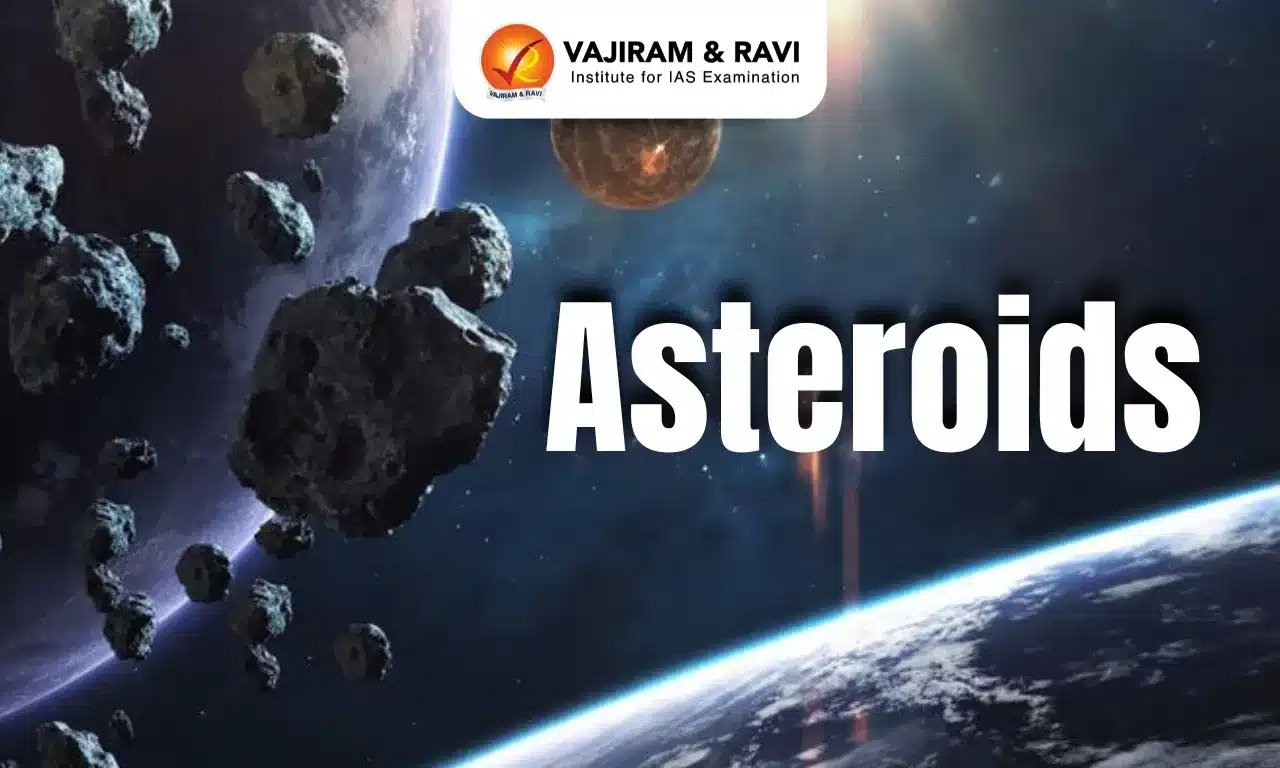Asteroids Latest News
A 14-year-old boy from Noida has earned recognition from NASA for his provisional discovery of an asteroid, currently labelled as ‘2023 OG40.’
About Asteroids
- Asteroids, sometimes called minor planets, are the rocky remnants of material leftover from the formation of the solar system and its planets approximately 4.6 billion years ago.
- They are small, rocky objects that orbit the Sun in highly flattened, or “elliptical” circles, often rotating erratically, tumbling, and falling through space.
- The majority of asteroids originate from the main asteroid belt, a region between the orbits of Mars and Jupiter.
- Asteroids are found in other places, too. For example, some asteroids are found in the orbital path of planets.
- This means that the asteroid and the planet follow the same path around the sun.
- Earth and a few other planets have asteroids like this.
- Although asteroids orbit the Sun like planets, they are much smaller than planets.
- Most asteroids are irregularly shaped, though a few are nearly spherical, and they are often pitted or cratered.
- Some asteroids are hundreds of miles in diameter, but many more are as small as pebbles.
- More than 150 asteroids are known to have a small companion moon (some have two moons).
- There are also binary (double) asteroids, in which two rocky bodies of roughly equal size orbit each other, as well as triple asteroid systems.
What is the International Asteroid Discovery Project (IADP)?
- It is a program affiliated with NASA’s International Astronomical Search Collaboration (IASC).
- It is a citizen science program which lets participants discover asteroids by using software and datasets.
- The citizen scientists can make original astronomical discoveries and participate in hands-on astronomy.
- The participants are provided with datasets from IASC, which they have to download.
- Calibrating them on Astronomica software, they then have to look for asteroids.
Asteroids FAQs
Q1. What is the largest asteroid in the universe?
Ans. The largest asteroid is called Ceres. It is about one-quarter the size of the moon.
Q2. How big is a comet?
Ans. Comets are frozen leftovers from the formation of the solar system composed of dust, rock, and ices. They range from a few miles to tens of miles wide.
Q3. Do asteroids hit planets?
Ans. Stray asteroids and asteroid fragments have slammed into Earth and the other planets in the past, playing a major role in altering the geological history of the planets and in the evolution of life on Earth.
Source: IE
Last updated on December, 2025
→ Check out the latest UPSC Syllabus 2026 here.
→ Join Vajiram & Ravi’s Interview Guidance Programme for expert help to crack your final UPSC stage.
→ UPSC Mains Result 2025 is now out.
→ UPSC Notification 2026 is scheduled to be released on January 14, 2026.
→ UPSC Calendar 2026 is released on 15th May, 2025.
→ The UPSC Vacancy 2025 were released 1129, out of which 979 were for UPSC CSE and remaining 150 are for UPSC IFoS.
→ UPSC Prelims 2026 will be conducted on 24th May, 2026 & UPSC Mains 2026 will be conducted on 21st August 2026.
→ The UPSC Selection Process is of 3 stages-Prelims, Mains and Interview.
→ UPSC Result 2024 is released with latest UPSC Marksheet 2024. Check Now!
→ UPSC Prelims Result 2025 is out now for the CSE held on 25 May 2025.
→ UPSC Toppers List 2024 is released now. Shakti Dubey is UPSC AIR 1 2024 Topper.
→ UPSC Prelims Question Paper 2025 and Unofficial Prelims Answer Key 2025 are available now.
→ UPSC Mains Question Paper 2025 is out for Essay, GS 1, 2, 3 & GS 4.
→ UPSC Mains Indian Language Question Paper 2025 is now out.
→ UPSC Mains Optional Question Paper 2025 is now out.
→ Also check Best IAS Coaching in Delhi

















